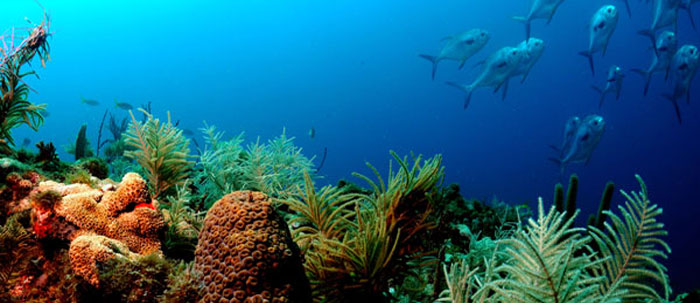The Florida Keys hold the key to a unique national treasure - North America's only living coral barrier reef and the third longest barrier reef in the world. Coral reefs contain more varieties of life than any other marine environment. They are part of a fragile ecosystem that includes mangroves and seagrasses on both the ocean and bay side of the Florida Keys. The coral reef ecosystem is alive with an abundance of fish, corals, sponges, jellyfish, sea turtles, dolphins, crabs, lobsters, rays, sea birds and other sea life. In fact, it is home to one third of Florida's threatened and endangered species.
 |
| Florida Keys National Marine Sanctuary Coral Reefs |
Take a moment to explore and learn about the coral reef that Florida Keys National Marine Sanctuary protects.
The people of Key West are strongly committed to preserving the natural beauty of the Florida Keys, and have built several sanctuaries throughout the Keys to protect endangered species. |
| Key Deer in natural habitat on Big Pine Key. |
On Big Pine Key there is the National Key Deer Refuge, The Key Deer were placed on the endangered species list as the population reached an estimated low of 27 in 1957 and has made a rebound to an estimate of approximately 800 today. Big Pine Key and No Name Key is estimated to have the most population, estimated at 600, with the remainder being on the other Lower Keys and Back-country islands.
The Key deer are the smallest of the 28 subspecies of Virginia white-tailed deer. Bucks range from 28-32" at the shoulder and weigh an average of 80 lbs. Does stand 24-28" at the shoulder and weigh an average of 65 lbs. Read more information on the National Key Deer Refuge
 |
| Three endangered species of the Crocodile Lake |
In north Key Largo is the Crocodile Lake National Wildlife Refuge, a wildlife sanctuary to protect and preserve critical habitat for the endangered American crocodile. The mangrove wetlands of the refuge provide habitat, solitude, and the only known nesting area on Key Largo for this reptile.
The refuge also protects a unique tropical hardwood hammock, which supports a high diversity of plant species, 80% of which are of West Indian origin. The refuge and the adjacent Key Largo Hammock State Botanical Site contain the largest continuous tract of hardwood forest remaining in the Florida Keys. These forests are home to several endangered and threatened species including the Key Largo woodrat, Key Largo cotton mouse, Schaus swallowtail butterfly, Eastern indigo snake and Stock Island tree snail.
 |
Great White Heron (Ardea herodias occidentalis) |
Key West and Great White Heron National Wildlife Refuges are found on the numerous small islands known locally as the Backcountry and are among the oldest refuges in the nation. These areas were set aside for the primary purpose of maintaining a preserve and breeding ground for native birds.The majestic great white heron is unique to south Florida and the Florida Keys. The nesting habitat of these birds is primarily on mangrove islands within Great White Heron National Wildlife Refuge and Key West National Wildlife Refuge. Birds forage on large, continuous turtle grass beds during a limited fraction of the tidal cycle. Destruction of seagrass beds by boating impacts can directly limit the availability and quality of forage habitat for these birds.
These two refuges consist of more than 200,000 acres of open water and over 8,000 acres of land on 49 islands. They protect habitat for a wide variety of birds, the endangered Atlantic green and loggerhead turtles and is the only breeding site in the U.S. for the endangered hawksbill turtle.
Try these activities:

No comments:
Post a Comment